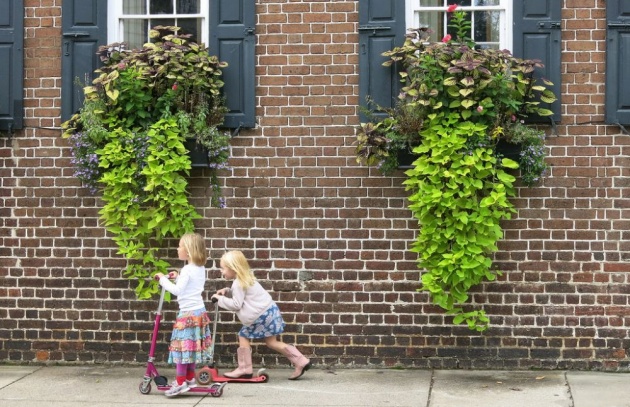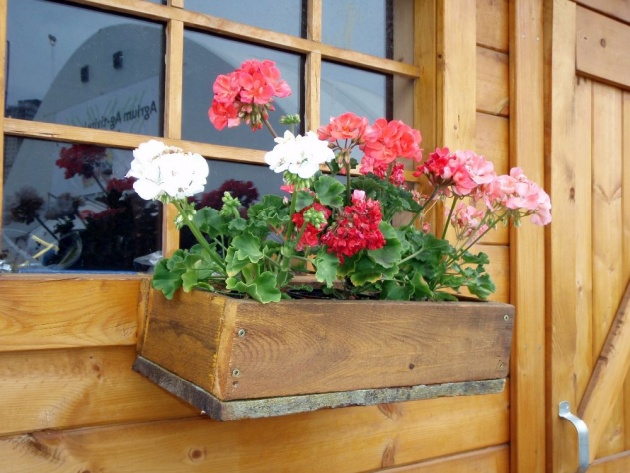London. The capital's countless interesting locations and rich multicultural background are often pushed to the background by its endless, bland rows of traffic lights and the rhythmic steps of millions of people – an image framed by a continuous outline of brick and concrete. It's almost as if a broken film projector shows the same black & white scene over and over again.
Your home doesn't have to be a part of this motion picture. A lovingly nurtured window box can inspire the mind and help break from the monotony that comes with daily routine. And your small Hanging Gardens can very easily become the focal point of your entire street! If you don't know where to start, simply grab a pen and paper and keep on reading.
Think Inside the Box
Window boxes in London come in hundreds of shapes, colours, and textures, and sifting through all of them to find the right ones would easily take you a lifetime. To avoid needless confusion, make a list of all desired features that you wish your containers to have. Then, grab a tape measure and write down the dimensions of your window ledges. Try to pick boxes that will match your window's size as closely as possible – if it's too small or too great, your box of vibrant greenery will seem a bit out of place.

Choosing the right planter brackets or bolts to support the weight of your small window boxes would mean a world of difference to the pedestrians below. Typically, your boxes will arrive with a set of decorative brackets that are also used for mounting. You absolutely need to make sure that they can carry the combined weight of the container and the soil within! If you're having any trouble mounting them, it's best to leave it in the hands of an experienced professional.
Base your choice of materials on your local weather's prominent features. As a Londoner, you are probably painfully aware of the heavy rain clouds that never seem to leave the horizon. In this case, red cedar boxes are a safe and elegant choice because of the wood's natural anti-rot and moisture resistance.
A small, but nonetheless important detail, is the aesthetic look of your window troughs. For example, a deep blue container will perfectly complement an arrangement that is heavily based around salvias. Containers with intricate iron frames, on the other hand, will remain appealing even during the winter season when they're as barren as a frozen tundra.
Learn Your Thrillers, Fillers, and Spillers
Creating lush flower arrangements becomes much easier once you grasp the Holy Trinity of window box planters – thrillers, fillers, and spillers. Do these words sound foreign to you? Allow us to clarify.
Imagine a play. On comes the spotlight and someone walks up the steps to the stage. This person's remarkable outfit and stellar performance immediately make it clear that this is, in fact, the leading actor. Tall and colourful, thrillers are the plants that carry the entire composition and, just like a leading actor, need to be in the centre of attention. Examples of such captivating flowers include Poppies, Asters, and Dahlias.
You can't have a play without an appropriate scenery. Fillers set the tone of the arrangement, they are the artificial trees and houses back on stage that make everything believable. Pick fillers that add texture to the composition and either echo or completely oppose the vibrant palette of your thriller. Begonias, Dusty millers, and Persian shields are a good place to start.
Even the most carefully crafted plot will crumble apart without a cast of supporting actors. Spillers are climbers that literally overflow over the edges of your window flower boxes to reach for the ground, adding a certain exotic vibe. Their main role is to soften the rough edges of the composition, but they can be also used to contrast your thrillers and fillers. Sweet potato vines, Morning Glory plants, and Asparagus ferns will go well with almost any composition.
Keep Your Horticultural Heaven Well Maintained
Your choice of materials dictates the maintenance needs of your window plant troughs. If you went with wooden boxes, you'll need to pick up an oil or resin-based wood sealant to protect their surface from warping or cracking. Classic terracotta pots, on the other hand, need an extra layer of gravel beneath the soil for proper drainage and may crack if you expose them to low temperatures. Plastic and metal boxes require almost no maintenance and are weather-resistant, but their downside lies in their relatively plain look.

Soil in containers tends to dry out faster than that in a regular garden and a proper soil mix is crucial to keep your vegetation healthy. Generally, you should mix it with soil amendments that retain as much moisture as possible. If you're not afraid from being condemned by the International Peat Society for using the product of eco-unfriendly mining practices, you can opt for peat moss. Synthetic powder and pellet-based alternatives are also widely available, though not as efficient.
Make sure to provide your window boxes with lots and lots of water, preferably on a day-by-day basis. Check your containers to see if they have a sufficient amount of drainage holes and pay special attention to where that water goes – you don't want soaking wet strangers constantly ringing on your doorbell, now do you? If you can't access your containers directly from your windows, consider installing an automatic watering system instead.



